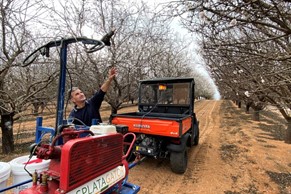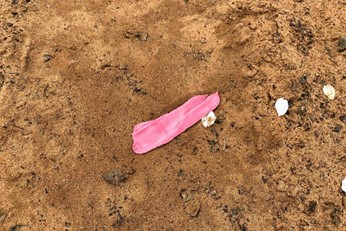How do you keep bees in your orchard when there are more attractive flowering plants in the vicinity? The answer may lie in pheromones.
Dollops of pheromones have been sprayed into flowering almond orchards near Robinvale, in north-west Victoria, with the aim of creating excitement among bees, thus creating more nuts.
Bees are essential for the fruit to set, so getting the insects to stay and do their job rather than go foraging in forests elsewhere is vital.
Organic Crop Protectants’ Tony Filippi said it was important to get the smell just right.
“The bee has many different pheromones that it emits,” he said.
“This one is a common one — it’s called the nasonov, and it stimulates the bee to let other bees know there’s something good out there.
“We’re using a novel bit of chemistry in a paste–like substance called SPLAT, which means Specialised Pheromone Lure Attractant Technique.”
OCP’s Tony Filippi checks that the ‘splatagator’ is hitting the right branches.(ABC Rural: Cherie Von Hörchner)
Mr. Filippi said he used a machine he called “the splatagator” to shoot pink, dough-like goo into the trunks of almond trees.
“We’re putting small dollops throughout the orchard to stimulate the bees to come into that part of the orchard, to work longer and to move a little further and more evenly through the orchard,” he said.
“It’s a biodegradable vegetable wax and it’s completely organic, so there’s no fear of lingering residues.
“It adheres to the tree and within a couple of hours will dry … and slowly emit the volatile or the pheromone.
“For this particular produce it can take over four to six weeks [to last].”
Dollops of waxy goo are shot into trees to help keep bees interested in staying in orchards for pollination season.(ABC Rural: Cherie Von Hörchner)
He said the substance could be applied in a few ways, depending on the size of the orchard.
“We have it available in a caulking gun, which can be hand applied and is good in small situations,” Mr Filippi said.
“But, in a commercial orchard, we have a machine where we can travel along [rows] between 10 and 12 kilometres shooting dollops into the trees.”
Luring goo has many features
Mr. Filippi said the Californian product could be used to seduce insects for a variety of purposes.
“The wax-like dollops carry whatever substance that we want into the tree,” he said.
“So… we can use it for a feeding attractant, attract and kill technique [pest insects] … and it can also have a repellent put in it.”
Mr. Filippi said weather played an important part in a successful pollination program. He said bees wouldn’t come out if the temperature was less than 13 degrees.
“You need to maximise bee activity within the orchard to cross-pollinate the flowers, so anything to enhance it will help it,” he said.
“What the bees are searching for is pollen and nectar. Nectar for food for themselves, but the pollen is very important to cap the brood or the eggs that they have in their cells within the hive. They need to put a cap over the top of them and they use pollen to do this.
“They do need to go out and do some foraging, especially when the colony is in growth phase, and the trouble with this time of the year is it’s very cold and wet periodically and it interferes with the bees foraging.”
Drone to monitor bees
Apiarist and Bee Innovative chief executive, David Lyall is also involved in the project. An Unmanned Aviation Vehicles (UAV) pilot, he flies a drone across the almond trees to assess bee activity.
“We’re using technology that we’ve developed to track where the bees are working in the orchard, and we provide that to the farmers so they can see which parts of their crops are being well pollinated and which areas are being poorly pollinated,” he said.
Mr. Lyall uses a radar-like sensor to watch the bees.
“We call it ‘beedar’, and effectively it’s the first time growers are able to track in real time where the bees are working,” he said.
“The radar emits a high energy signal, and that bounces back off the crop and the bees and other insects that are working in the crop.
“We’ve got an algorithm that differentiates from other insects and other objects in the orchard based on their size, density and flight pattern.”
Mr. Lyall said that while the technology might appear to be manipulative, it was originally designed to protect bees from their enemies.
“The genesis to look at the problem was really about developing technology to help keep varroa destructor mite out of Australia,” he said.
“Varroa is a terrible blight on the beekeeping industry around the world and Australia at this stage is lucky enough to be the only country left on the planet that doesn’t have it.
“With support from CSIRO we were able to uncouple the Beedar sensor out of that biosecurity package to help commercial pollination.”
________________________________________________________________________________









